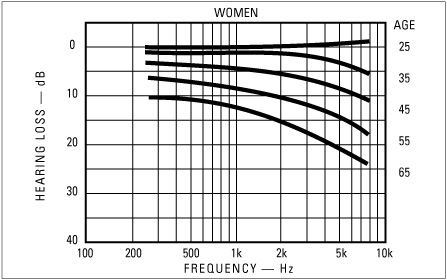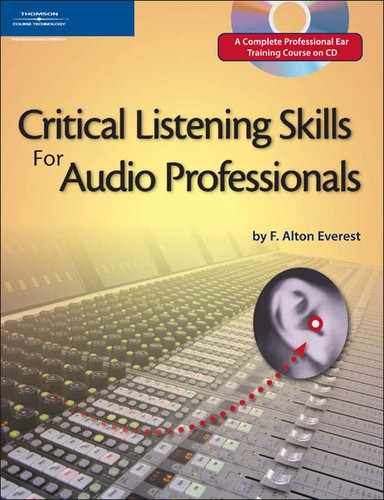Protect Your Hearing!
Our sense of hearing is irreplaceable. All the work being done on cochlear implants offers nothing that approaches the performance of our natural hearing. Therefore, the hearing we now have is all that there is. We may augment deficient hearing with hearing aids, but no hearing aid works as well as our original, undamaged equipment.
The acuity of hearing of a typical group of Americans is shown in Fig. 9. The 1-percent curve represents “normal hearing” for a healthy young adult. Only 1-percent of the population can claim acuity this keen. The 10-percent curve means that 10 percent of the group could hear a sound as weak or weaker than the curve indicates. There is not much room between the 1 percent and 50-percent curves, indicating that half of the population has hearing acuity indicated by the 50-percent curve or the ones below it. Only 1-percent of the group have hearing acuity as bad as the 99-percent curve. The higher the curve, the louder sounds must be to be heard by the percentage of people indicated. This curve shows that a very significant portion of the population lives with some hearing impairment.
Figure 9. A survey of hearing acuity of a group of typical Americans made by the U.S. Public Health Service. These curves show the least sound that can be heard in dB above the reference level. The 10-percent curve means that 10 percent of the group could hear a sound as weak as or weaker than what the curve indicates

The modern world seems bent on destroying this beautifully contrived hearing system. “Recreational deafness” is a term solidly embedded in today’s scientific terminology. Professional sound mixers working at 110 dB levels are flirting with damaged ears. Some motorcycles and other off-road vehicles can generate hazardous noise levels. Those around firearms are subjected to impulsive noises that sneak through the limiting devices of the middle ear to reach the inner ear unattenuated. The very popular portable music players used with earphones can subject ears to hazardous levels.
What is the effect of the noisy environment? The measurement of many people has given us the information in Fig. 10. In these curves the average hearing loss for men is given as a function of age and frequency. This loss is primarily in the high frequencies and amounts to 20 dB at 8 kHz for a 45-year-old man. Such a high frequency loss means that, for this person, the high partials and overtones of music are attenuated and the musical balance is upset. Timbre, growth, decay, volume, and presence are musical factors most affected by such a loss. Pitch duration, time, vibrato, rhythm, and to some extent, loudness are least affected. The only mistake one has to make to inherit such high-frequency hearing loss is to grow older.
Figure 10. Age-related hearing loss in men as a function of age and frequency Figure

Fig. 11 shows the comparable situation for women. The losses for women are less than those for men. A 45-year-old woman, on the average, will have a loss at 8 kHz of about 11 dB, 9 dB less than a man of the same age.
Figure 11. Age-related hearing loss in women as a function of age and frequency

Self-delusion appears to be a favorite pastime of humans. It seems that those most dependent upon keen and accurate hearing for their livelihood are the most reluctant to admit the possibility of having a hearing impairment. For them to go to an otologist or audiologist for a hearing check-up would be a tacit admission that something is wrong. This is a most unfortunate attitude. Audiograms reveal the truth: either everything is satisfactory or there are problems that should be faced—and the sooner the better. There is no escape from age-related hearing losses. Every informed person knows, or should know, that the older the person, the more the high frequencies drop. The wise musician, audio engineer, or recording mixer will do well to have periodic appraisals of hearing acuity.
Two typical audiograms are shown in Fig. 12. Person A certainly has nothing to fear. Both the right and the left ear exhibit perfect acuity. Person B is at the ragged edge of a serious hearing problem. It is generally considered that an average hearing loss of 25 dB for 500, 1000, and 2000 Hz will be a handicap.
Figure 12. Typical audiograms. (A) Audiogram for a person with perfect hearing. (B) Audiogram for a person with a serious hearing impairment. It is generally regarded that an average hearing loss for 500, 1000, and 2000 Hz of 25 dB indicates a hearing handicap

The audiogram of Fig. 13 is a fictitious one, but the big dip in the 3000 to 5000 Hz region is the sort of impairment that results from exposure to excessive sound levels over extended periods of time. It is interesting to note that workers in jute mills at the turn of the century showed the same type of dip that characterizes impairments among modern music workers.
Figure 13. Typical audiogram of person with nerve damage inflicted by excessive noise over a prolonged period of time

When hearing acuity is reduced, the musician or audio worker turns up the volume to compensate for the loss. This in turn increases the dosage, bringing further damage to the hearing system. A vicious cycle is thus initiated, hastening the deterioration of hearing.
Considerable attention in the units of this course is given to the all-important critical bands. The precision of the analysis of sound taking place in the ear depends upon the sharpness of these critical-band turning curves. It is now recognized that another result of damage to the hair cells is a broadening of the critical bands, which results in coarser frequency analysis and poorer signal-to-noise ratios.
